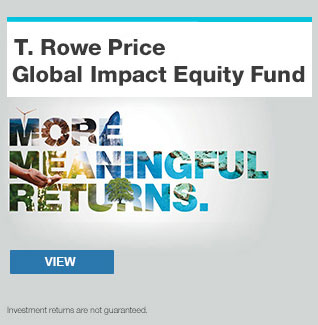October 2023 / IMPACT INVESTING
Circular Economy and Waste Reduction
The Challenge
One of the most pressing issues for our planet is the speed at which we are consuming our natural resources and the waste that results from that consumption.
Population growth and a secular trend of rising personal consumption result in an estimated 2.24 billion tons of waste creation per year, amounting to a footprint of 0.79 kilograms per person per day.1 While estimates vary by study, in 2021 the United Nations (UN) estimated that 300 million tons of plastic waste alone was being created annually, an amount that is almost equivalent to the entire weight of the human population.2 Humans inhaling and consuming microplastics via our air and food chains is now a harsh reality of our collective footprint, emphasizing the urgency needed to address the problem.
Reducing waste as the global economy grows and as standards of living rise will be difficult, but the principle of sustainable consumption and resource management can be addressed by transitioning to a more circular economy. We need to move from an inherent make-use-and-dispose economy to a model that focuses on the continuous and recycled use of resources to help reduce waste and its negative impact on the environment.
The Role of Investors
Any solution to the growing waste issue demands a scaled response. This will mean a combination of public and private infrastructure investment, government incentives, and societal engagement to engender the behavioral change needed. Encouragingly, many companies are starting to recognize the benefits of more efficient consumption and are identifying growing customer demand. Within our impact investment universe, we have identified several firms that are helping to advance the push toward a circular economy in areas that include product innovation, recycling and packaging, and waste management.
Innovation in Products and Services
Rethinking production techniques and finding ways to innovate the manufacturing process to help reduce waste are critical to the shift to a circular economy. One impactful way of improving resource use is to create products from waste itself, as is the case for Trex, a wood manufacturer based in the U.S. Its composite decking, made in part from plastic from landfill and recycled wood, is a notable example of the type of innovation companies are developing to solve for these problems. Reducing duplication and under-utilization of products is another highly effective way of cutting waste. Ashtead, a construction equipment company, leases out its steel machinery equipment to help lift the utilization rate of privately owned and steel- intensive machinery (from an average of 16% to Ashtead’s own utilization rate of 70%), thus saving carbon emissions from steel production.
Waste Management and Reduction
One very damaging, but less discussed aspect of waste is its propensity to generate methane as it decomposes. Methane has a global warming potential of between 84 and 87 over a 20-year life span (carbon dioxide is the reference point of 1 on this scale).3 By investing in methane recovery systems at its waste sites, Waste Connections is helping to mitigate the release of methane into the atmosphere. The firm also manages recovery and recycling, primarily from paper and cardboard. Darling Ingredients (case study to follow) is also engaged in waste reduction and methane avoidance by manufacturing biofuel from the byproducts of animal processing and rendering.
Recycling and Packaging
Estimates of the global total amount of plastic recycled range between just 10% and 20%.4 With approximately 11 million tons of plastic waste entering our oceans per annum (an amount estimated to triple in the next 20 years), there is a huge amount to be done to address the problem. We believe the long-term solution requires a dramatic rethink of packaging and a shift away from plastics. In the interim, recycling has a key role to play in the transition. Countries like Norway are leading the way with policy, implementing a deposit return scheme that has helped drive the recycling rate of polyethylene terephthalate bottles up to around 97%.
Tomra (case study to follow) has been at the vanguard of the recycling process, with a mission to increase its collection of containers from 45 billion to 500 billion by 2030. Meanwhile, Ball Corporation’s highly recyclable packaging is also contributing positively as its aluminum beverage containers have high recycled content of greater than 60%, which helps to reduce the amount of waste entering landfills. Aluminum recycling has around 5% of the carbon intensity compared with other products. It is also true that about 75% of all aluminum ever produced is still in use today.5 Almost 70% of aluminum cans are recycled, making them the most recycled drinking container on the planet.3
IMPORTANT INFORMATION
This material is being furnished for general informational and/or marketing purposes only. The material does not constitute or undertake to give advice of any nature, including fiduciary investment advice, nor is it intended to serve as the primary basis for an investment decision. Prospective investors are recommended to seek independent legal, financial and tax advice before making any investment decision. T. Rowe Price group of companies including T. Rowe Price Associates, Inc. and/or its affiliates receive revenue from T. Rowe Price investment products and services. Past performance is not a reliable indicator of future performance. The value of an investment and any income from it can go down as well as up. Investors may get back less than the amount invested.
The material does not constitute a distribution, an offer, an invitation, a personal or general recommendation or solicitation to sell or buy any securities in any jurisdiction or to conduct any particular investment activity. The material has not been reviewed by any regulatory authority in any jurisdiction.
Information and opinions presented have been obtained or derived from sources believed to be reliable and current; however, we cannot guarantee the sources' accuracy or completeness. There is no guarantee that any forecasts made will come to pass. The views contained herein are as of the date noted on the material and are subject to change without notice; these views may differ from those of other T. Rowe Price group companies and/or associates. Under no circumstances should the material, in whole or in part, be copied or redistributed without consent from T. Rowe Price.
The material is not intended for use by persons in jurisdictions which prohibit or restrict the distribution of the material and in certain countries the material is provided upon specific request.
It is not intended for distribution to retail investors in any jurisdiction.


